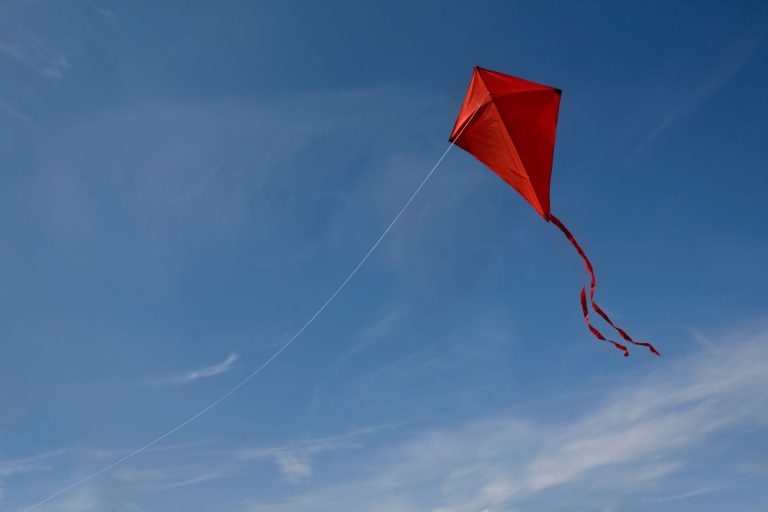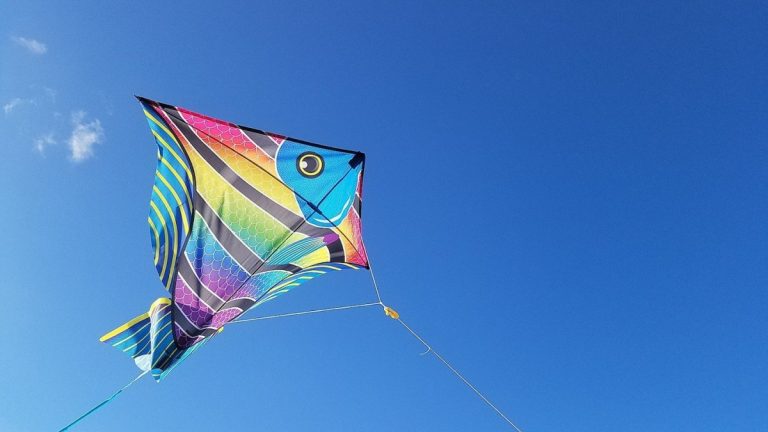How To Fly A Two-Line Parafoil Kite
Many appreciate parafoil kites for how versatile they are. These kites have received the name soft kites because they are easy to fly and get their shape from the wind.
Unlike other traditional kites, parafoil kites lack a frame. It means that this kite eliminates the tedious assembly of kite parts. In winds of 6-20 mph, you can quickly launch these kites.
You must remember various steps when flying a parafoil kite.
The steps include;
- Finding the right location
- Unwinding the two flying lines
- Attaching lines to kite (if applicable)
- Securing the kite on the ground
- Launching the kite
Flying A Two-Line Parafoil Kite
Finding The Right Location
Kite flying is an intriguing sport that you can enjoy at various spots. However, not every area is ideal for kite flying. A clear site free of obstacles is the most ideal when flying kites. These include beaches, farms, and parks.
It is also imperative to pick spots free from people or further from them. Especially if such individuals are not involved in kite flying, this is to be courteous and avoid disrupting them from whatever activity they were undertaking.
Another reason why it’s necessary to stay away from people is to avoid accidents. For example, a kite flyer may entirely concentrate on flying their kite and become oblivious to the individuals around them. It can cause them to bump into each other or trip. Kite flyers, however, should always be aware of their surroundings.
Picking flying spots that are clear of obstacles directly impacts how the kite flies. It is because kites depend highly on the wind to fly. In areas with obstacles such as trees and buildings, you might experience turbulence. It means that such environments are inappropriate because of the unsteady winds, which can cause kites not to fly.
Unwinding The Two Flying Lines
Once you arrive at your ideal location, take the kite out and unfold it. Proceed to lay it down with the lower skin facing upwards. It will help if you put some sand on the kite to secure it and keep the wind from blowing away.
Once the kite is secure, one should proceed to unwind the flying lines. The best way to do this is by starting close to the kite and slowly backing away while unwinding the kite. For an easier launch, one should walk opposite the direction of the wind.
After that, you should attach the lines to a set of control handles. These handles will assist kite flyers when steering the kite.
Attaching Lines To Kite (If Applicable)
It would be best to use A lark’s head knot to attach the lines and the kite. However, this step only applies to unattached kites. Other store kites come with the lines already attached.
Securing The Kite On The Ground
Ensure that the kite is still secure on the ground. Kite operators should stand so that the kite lines are at an angle to the direction of the wind. Preferably, 45 degrees.
Launching The Kite
By checking again to see no people nearby, kite operators should hold on to the handles and slowly walk back. It will cause the kite’s leading edge to start rising, and the sand will fall off. Once the kite launches, there is no need to keep walking.
Adults must try them out with steerable parafoil kites before allowing kids to have a go at them. It is because these kites tend to pick up speed, and their pull is different from that of single-line parafoil kites.
How Do I Launch A Parafoil Kite?
How Do You Start A Dual-Line Kite?
Unlike most kites, rest assured that parafoil kites often don’t have parts that will break even with serious crashes. It means that if you’re a beginner, you can breathe a sigh of relief if you don’t get things right the first time.
However, launching parafoil kites is an easy task that can quickly get you on the kite flying adventure. Securing the kite before flying is essential, as mentioned before. When at the beach, one can easily use sand. If you are in a different location, you can use tiny stones. However, they shouldn’t be sharp as they can cause tears on the kite sail (Source).
Once you slowly pull the kite and the sand fall off, all you need is a little tag to the lines, and the kite will fly.
How Do You Release A Kite?
In most cases, one can effortlessly launch the kite on their own. However, sometimes the kite may fail to launch, and you may need assistance from a friend. It is known as the long line method launch.
The friend should get hold of the kite and walk downwind. While they do this, you should let out the kite’s line. The friend should then hold the kite with the nose facing upwards. Once you signal your friend, they should let the kite go as you pull the line. It would be best if you pulled the string in until the kite is willing to climb on its own.
How Do You Control A Two-String Kite?
When it comes to single-line kites, you must carry out a limited amount of steering to control the kite. For a forward launch, all one needs to do is sharply tug on the line. It will result in the kite moving in the leading-edge direction.
On the other hand, if kite operators want the kite to move backward, they should let a bit of slack in the line. This movement will also cause the kite to move to either side. All that is needed is practice for one to learn how to control the kite in various directions efficiently.
Learning to control and steer kites is a necessary component of kite flying. It is because kite flyers don’t have to be bored with the monotony of holding kites in one position. Instead, they can have more fun with the sport by doing various tricks such as loops.
Kite operators who have mastered single-line kite flying upgrade to dual-line kites as it offers more challenges hence a more exciting kiting adventure.
You can move dual-line kites in any direction with simple and tactful hand movements. Such kites have handles that allow you to hold the kite lines in each hand. Pulling the right-hand line causes the kite to move to the right, and pulling the left-hand line causes the kite to move to the left.
Is Pushing Possible?
Pushing instead of pulling is also possible, resulting in quicker and smoother turns. Advanced Kite operators master this skill, allowing them to appreciate these types of kites even more.
Pushing the lines causes the kites to behave, opposite to how pulling the kites causes them to act. For example, pushing the right hand causes the kite to turn left and vice versa. When pulling lines, you also pull the wind into the kite, which causes the kite to move fast during a turn. When attempting to perform a stall, this acceleration can make it difficult.
Pushing, on the other hand, causes the wind to leave the sail when turning, which causes the kite to move slowly. In this case, stalling becomes easier. Practicing both pull and push turns allows kite pilots to have better control of their kites.
How Do You Change The Direction Of A Kite?
Changing the direction of a kite, therefore, entirely relies on the hand movements made by the operator. It also depends on whether the kite operator pulls or pushes their hand with each action resulting in a different kite movement.
Kite operators should, however, be keen as holding down a single line for long periods can cause the kite to spin. While this may look fun and feel exciting at the time, it may result in tangled lines. A quick fix is finding balance again and steering the kite in the opposite direction. The kites become untwisted (Source).
How Do You Land A Two-Line Kite?
Knowing how to land a kite is just as essential as knowing how to launch it. Therefore, the proper technique will ensure that you launch it successfully. Some kites cannot withstand hard crashes, and operators should strive to launch kites gently. It may be difficult for first-time dual-line kite flyers; however, they can comfortably do this with time.
The kite should be steered to the side for it to land. The kite won’t pull as much and will also start losing altitude. Operators should slowly let the kite lose altitude until it touches the ground. To relaunch the kite, one must gently tug the control lines evenly with the left and right. It should be followed by gently steering the kite to the center (Source).
Once you learn how to control your kite and master its behavior, you can explore its wind window. In front of the kite flyer, down low, is the power zone. It is where the kite pulls hard and causes it to speed up. The hand movements should be slower to achieve control. Notice how harsh and light winds affect your kite as you fly. To increase speed, take some steps backward, and to slow down, take a few steps forward (source).
Are Parafoil Kites Easy To Fly?
How Does A Parafoil Kite Work?
Parafoil kites are unique compared to other kites as they lack a rigid frame. One can compare them to parachutes to better understand how these kites look. The parafoil kites are mostly made from ripstop nylon (Source).
The parafoil kite has both a lower and an upper skin with fabric cells sewn between them. When placed in ideal flying conditions, the fabric cells fill up with air and give the kite its shape. The leading edge contains openings that allow air into the cells, and in turn, the air pressure that results from this provides the kite with its form and will enable it to fly.
Other features that ensure the kite flows effectively include its unique bridling system. Its purpose is to contribute more to the shape and aerodynamics of the kite. It enhances the angle of attack. The effective bridling also adds stability and efficient maneuverability to the kite.
Parafoil History
The late Domina Jalbert developed parafoil kites in 1964. Domina was known for designing kites and was also involved in creating kites used for transporting scientific instruments (hybrid-balloon kites).
He foresaw the parafoil kite as a usage to recover space equipment or to suspend an aerial platform. In the initial stages, the parafoil kite had difficulty behaving like a parachute because of deployment shock.
However, once he added the drag canopy, the parafoil kite became an effective parachute. He added the drag canopy to the riser lines, slowing the spread. Unlike a round canopy with poor steerability compared to the drag canopy (Source).
Parafoils are helpful for various wind sporting activities, including kitesurfing, kite-flying, paragliding, powered parachutes, and skydiving. The parafoil-variant is the biggest kite in the world.
What Is The Easiest Kite To Fly?
The four easiest kites to fly are the delta kites, diamond kites, parafoil kites, and novelty kites. Kites prefer each for its different characteristics (Source).
When it comes to assembly, delta kites are easier. Once bought, kite operators would find two rods to be inserted into the sail pockets and form the kite frame. After placing the rods into their respective spots, the line must be attached to the kite keel.
Diamond kites are also easy to put together. One can purchase diamond kite materials online and set it up. Alternatively, one can find materials for making the diamond kite home and minimize costs.
You can often fly the single-line and two-line parafoil kites over the sand. Unlike diamond kites, it isn’t common to find parafoil kites built at home. The simple kites can equally be difficult to set up (Source).
Prism Synapse Dual-Line Parafoil Kite Review 2022
The prism synapse dual-line parafoil kite is an excellent dual-line kite that both beginners and advanced kite flyers will appreciate. The dual lines create chances to practice new tricks impossible with single-line kites.
The instant setup allows you to start kiting immediately, and the storage bag that comes with it ensures that you are always travel-ready.
The kite comes in several colors: cilantro, coho, and mango, allowing you to choose the most appealing to you.
The absence of a frame makes sure that you don’t have to worry about breakage in the off chance the kite crashes.
It’s Features
This kite has everything you need to start your kite flying, including 60′ x 80# polyester lines, a storage bag, instructions, and a winder.
Prism kite technologies have been in the market for about 25 years and have produced many high-quality kites. The stability of the prism synapse dual-line makes it easier for beginners to learn to fly this kite. Its appealing nature is bound to cause envious glances from other kite flyers.
The kite has received a rating by 1,440 people on Amazon, averaging a 4.5 out of 5 stars. Some of the positive factors that have stood out for this kite include quality of material, value for money, and durability.
Children will enjoy learning how to fly this kite and will make more trips to the outdoors once they master how to do it. However, this kite is not only limited to children. Adults, too, will enjoy having a go at this kite.
If you are looking for a fun yet forgiving kite when starting, then the prism synapse dual-line kite is for you.







